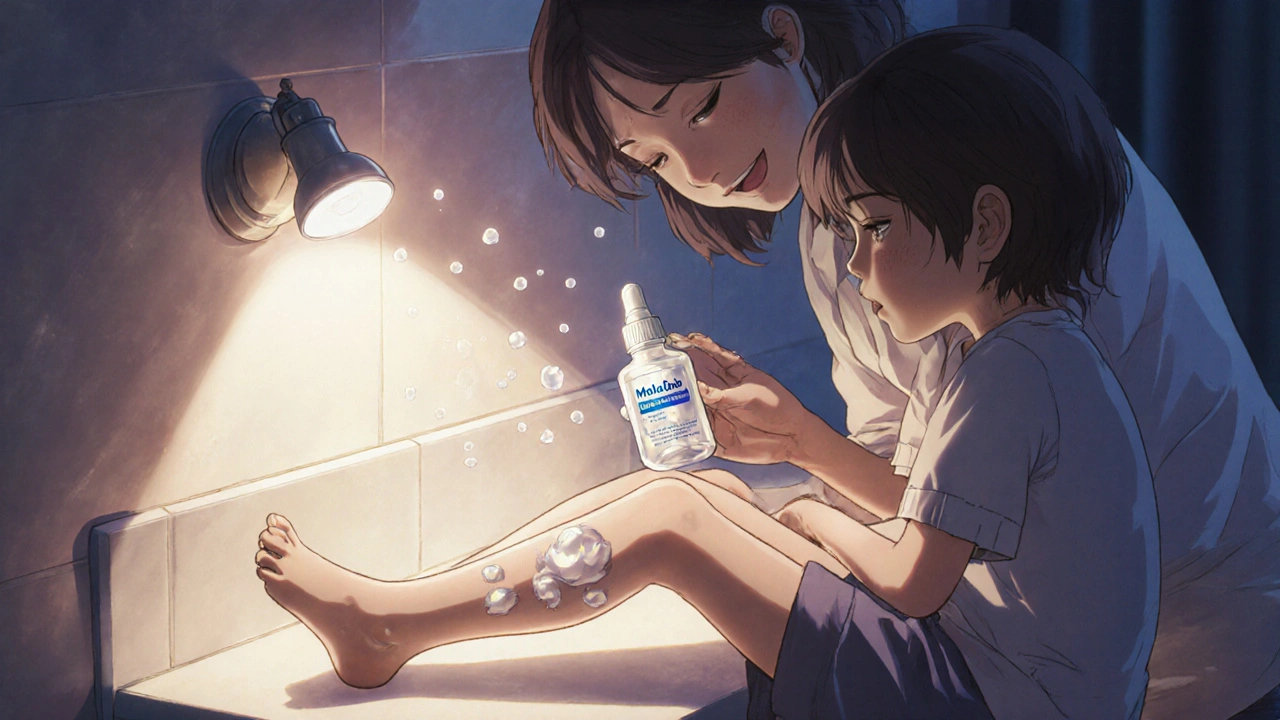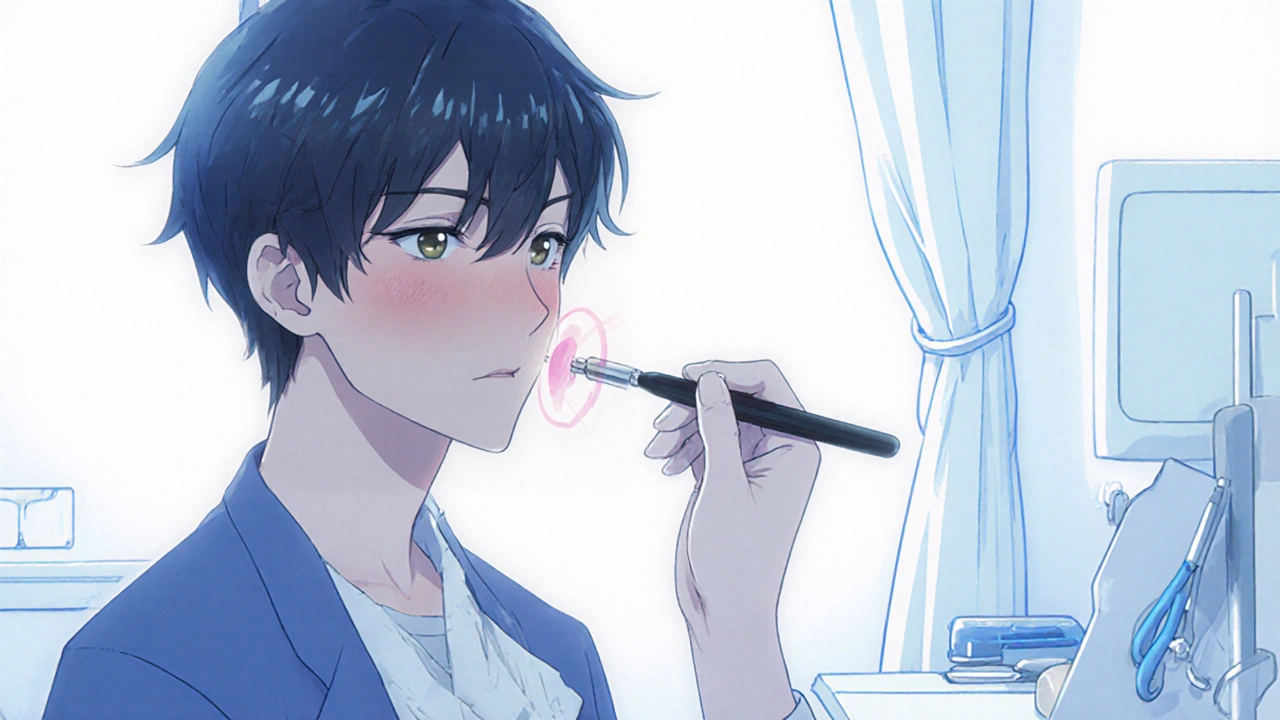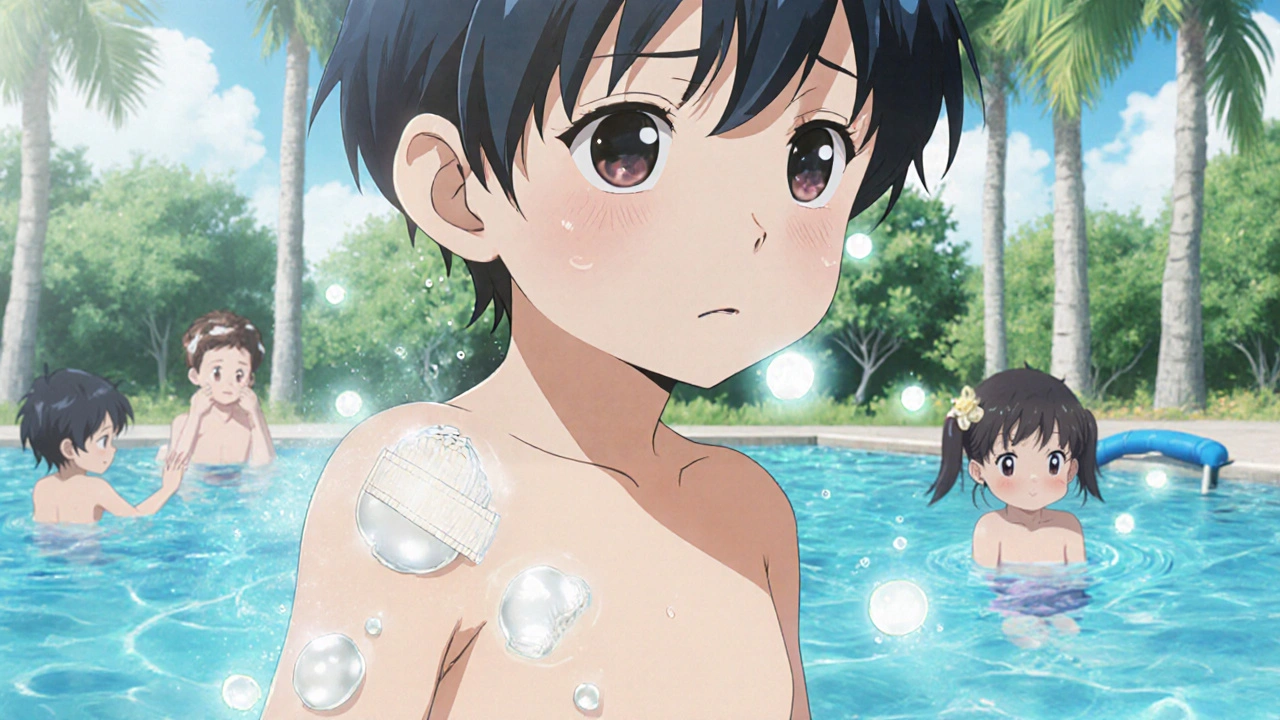When you notice small, round, pearly bumps on your child’s arm or your own inner thigh, it’s easy to panic. Are they warts? A rash? Something serious? If they have a tiny dimple in the center, you’re likely looking at molluscum contagiosum - a common, harmless, but highly contagious viral skin infection. It’s not dangerous, but it can be annoying, embarrassing, and spread fast - especially in kids, swimming pools, and households with eczema.
What Exactly Is Molluscum Contagiosum?
Molluscum contagiosum is caused by a virus called MCV, part of the poxvirus family. It’s not new. Doctors have known about it since the 1800s. But it’s still everywhere. In the U.S., about 450,000 to 600,000 children get it every year. It’s most common in kids between 1 and 10 years old, but adults can catch it too - usually through sexual contact or if their immune system is weakened. The bumps themselves are small, firm, and dome-shaped, usually between 2 and 6 millimeters wide - about the size of a pencil eraser. They’re often white, pink, or skin-colored, with a shiny, pearly look. The key sign? A tiny dimple or dot right in the middle. That’s called an umbilication, and it’s what sets molluscum apart from other skin bumps. Unlike warts (which are caused by HPV and feel rough), or chickenpox blisters (which burst and crust over), molluscum bumps stay smooth and intact. They don’t hurt. They don’t itch much - at least not at first. But if you scratch them, they can spread like wildfire. Each bump contains a thick, white core of virus particles. Scratch one, and you’re spreading the virus to nearby skin.How Does It Spread?
The virus spreads easily through direct skin contact. That means hugging, wrestling, sharing towels, or even sitting on the same bench at the pool. It thrives in warm, damp places. Kids with eczema are 30% more likely to get it - their damaged skin barrier makes it easier for the virus to sneak in. It doesn’t float in the air. You can’t catch it just by being near someone. But sharing a towel, a bath sponge, or even a swimsuit? That’s a high-risk move. Swimming pools aren’t automatic transmission zones, but if someone with molluscum scratches and then touches the water, the virus can linger. That’s why many U.S. pools require lesions to be covered - 32 states have policies requiring it. In adults, genital molluscum is often a sexually transmitted infection. It’s not listed as an STI like chlamydia, but it behaves like one. One Reddit user shared how he avoided dating for 14 months because of bumps on his penis. He wasn’t sick. He wasn’t in danger. But the fear of judgment kept him isolated.How Long Does It Last?
Here’s the good news: it almost always goes away on its own. In healthy kids and adults, most bumps disappear in 6 to 12 months. Some take up to 2 years. Rarely, they hang around for 4 years. But here’s the catch: while they’re there, each bump can spawn more. One bump can turn into 10, then 50, if you keep scratching or sharing towels. Studies show 92% of cases resolve without treatment within 18 months. That’s why the American Academy of Dermatology says: for most people, watchful waiting is the best first step. No need to rush into painful procedures. But for immunocompromised people - those with HIV, cancer, or on strong immune-suppressing drugs - molluscum can go wild. Lesions can grow larger than 30mm, multiply rapidly, and last years. In these cases, treating the underlying condition (like restarting antiretroviral therapy) is often the only way to clear the bumps.What Doesn’t Work (And What Can Hurt)
There’s a lot of noise out there. You’ll see ads for “miracle creams,” “natural remedies,” or “quick-fix cryo kits.” But most of them don’t work - and some make things worse. Cryotherapy (freezing with liquid nitrogen) is common in dermatology offices. But for kids, especially on the face, it’s often overused. One in five parents on RateMDs say their child got scarring from freezing. The bumps aren’t painful enough to justify the risk. Same goes for scraping (curettage) or laser treatments. These are invasive. They hurt. They can leave marks. And for a virus that will vanish on its own? The risk doesn’t match the reward. Even over-the-counter wart removers? Don’t use them. They’re made for HPV, not molluscum. They burn the skin, don’t kill the virus, and can cause more irritation.
What Actually Works?
There’s no magic bullet, but some options have real data behind them. Cantharidin - a blistering agent applied by a doctor - is the most proven treatment. In clinical trials, it cleared 73% of cases after 12 weeks, compared to 26% with placebo. It’s painless during application, causes a small blister that lifts the virus out, and leaves little to no scarring. It’s not available over the counter, but many dermatologists keep it in stock. Topical potassium hydroxide (KOH) - often sold as “MolluDab” - is a popular choice among parents. A 5-10% solution applied daily for 6-8 weeks clears up 63% of cases, according to Amazon user reviews and small clinical studies. It’s cheap, easy to use, and non-invasive. The downside? It can sting. And it requires consistency. Miss a day, and you’re back to square one. Immunomodulators - new drugs like imiquimod or topical cidofovir - are being tested. A phase 2 trial in 2023 showed an 82% clearance rate with a new immunomodulator, far outperforming placebo. These aren’t widely available yet, but they’re the future. For kids with eczema and molluscum? Treating the eczema first helps. Moisturizing, avoiding harsh soaps, and using gentle steroids reduce skin damage - which cuts down on how fast molluscum spreads.How to Stop It From Spreading
The best treatment is prevention. Here’s what actually helps:- Don’t scratch. This is the #1 cause of spread. Keep fingernails short. Use mittens at night for young kids.
- Don’t share towels, clothes, or toys. Wash everything in hot water. Dry on high heat.
- Cover bumps during swimming. Use waterproof bandages or rash guards. Most pools require this.
- Avoid shaving over bumps. If you have them on your legs or groin, don’t shave until they’re gone.
- Wash hands often. Especially after touching the bumps.
When to See a Doctor
You don’t need to rush to the dermatologist for every bump. But you should go if:- The bumps are on the genitals or face and causing distress.
- They’re growing rapidly or becoming red, swollen, or pus-filled (sign of bacterial infection).
- Your child has eczema and the bumps are spreading fast.
- You’re immunocompromised - this needs medical attention.
- The bumps haven’t improved after 18 months.

What Parents Should Know
Most parents (78%) choose no treatment for their kids, according to a BabyCenter survey. They follow Harvard Medical School’s advice: wait it out. And they’re right - for most kids, it’s not worth the stress. But here’s the emotional reality: kids with visible bumps on their face or arms get teased. A 2021 study found 45% of school-aged children with facial molluscum experienced bullying or social withdrawal. That’s not just about skin - it’s about confidence. If your child is being teased, treatment isn’t just medical - it’s emotional. A few weeks of KOH cream or a doctor’s cantharidin treatment can restore their sense of normalcy.What Adults Should Know
If you’re an adult with genital molluscum, don’t panic. It’s not a sign of promiscuity. It’s a common virus. But it does mean you need to be honest with partners and avoid sex until it’s gone. Use condoms - they help, but don’t fully prevent spread since the virus can be on skin outside the covered area. If you’re immunocompromised, talk to your doctor. Molluscum can be a sign your immune system needs support. Treating it alone won’t work - you need to fix the root cause.The Bottom Line
Molluscum contagiosum is annoying, contagious, and sometimes embarrassing - but it’s not dangerous. It doesn’t cause cancer. It doesn’t lead to long-term health problems. In healthy people, it goes away on its own. The best approach? Patience, hygiene, and avoiding unnecessary treatments. For kids, wait. For adults with visible or sensitive bumps, try KOH cream or ask your doctor about cantharidin. Skip the freezing, skip the lasers, skip the miracle creams. And remember: you’re not alone. Millions of kids and adults have had this. It’s not a failure. It’s just a virus. And like most viruses, it will pass.Is molluscum contagiosum contagious?
Yes, molluscum contagiosum is highly contagious. It spreads through direct skin-to-skin contact, sharing towels or clothing, or touching contaminated surfaces like pool edges or toys. It can also spread from one part of the body to another if you scratch or pick at the bumps. The virus stays active on surfaces for hours, especially in warm, damp environments.
Can adults get molluscum contagiosum?
Yes. While it’s most common in children, adults can get it too - especially through sexual contact. In adults, it often appears on the genitals, inner thighs, or lower abdomen. Adults with weakened immune systems (due to HIV, chemotherapy, or long-term steroid use) are at higher risk for widespread, persistent cases.
Does molluscum leave scars?
Usually not. When molluscum clears on its own, it rarely leaves scars. But aggressive treatments like freezing, scraping, or laser therapy can cause scarring - especially on sensitive skin or in children. Scratching the bumps can also lead to secondary infections and scarring. The key is to avoid picking and to use gentle, evidence-based treatments.
Should my child stay home from school or swimming?
No. According to updated CDC guidelines (2023), children with molluscum contagiosum should not be excluded from school, daycare, or swimming activities. The virus spreads through direct contact, not through water or air. Covering bumps with waterproof bandages during swimming is recommended, but isolation is unnecessary and can cause emotional harm.
How is molluscum different from warts?
Molluscum bumps are smooth, round, and have a central dimple (umbilication). Warts, caused by HPV, are rough, hard, and lack the central dot. Molluscum is usually painless, while warts can be tender, especially on the feet. Molluscum often appears in clusters, while warts tend to be isolated. Treatment for warts (like salicylic acid) doesn’t work on molluscum.
Can molluscum come back after it clears?
Yes, but it’s rare. Once the body clears the virus, most people develop immunity and won’t get it again. However, if you’re exposed to the virus again - especially if your immune system is weak - you can get a new infection. It’s not a reactivation of the old virus; it’s a new exposure. That’s why hygiene and avoiding contact with infected people or objects matters even after the bumps are gone.
Are there any natural remedies that work?
There’s no strong scientific proof that tea tree oil, apple cider vinegar, or iodine cure molluscum. Some people report success, but these remedies can irritate the skin and make the condition worse. The only natural treatment with clinical backing is potassium hydroxide (KOH), which is available in compounded topical creams. Even then, it’s not “natural” in the sense of being unregulated - it’s a medically formulated solution.
How can I tell if a bump is molluscum?
Look for small, dome-shaped bumps with a central dimple. They’re usually skin-colored, pink, or pearly white. They’re firm to the touch, not soft like a cyst. They don’t hurt or itch much unless scratched. If you’re unsure, a dermatologist can confirm it with a quick visual exam. In rare cases, they may use a dermatoscope to see the virus core inside the bump.


Comments
Brandy Walley
lol so molluscum is just nature's way of telling you to stop touching everything
also why is everyone acting like this is some new plague its been around since the 1800s
shreyas yashas
i had this as a kid in delhi. my mom just rubbed neem leaves on it. no doctor, no cream, no drama. it went away in 3 months. sometimes the old ways work better than the fancy ones.
Suresh Ramaiyan
it's interesting how we treat viral skin stuff like it's a moral failure. you get a cold, no one blames you. you get molluscum, suddenly you're a hygiene villain. the real issue isn't the virus-it's the shame we attach to it. maybe we need to normalize it like we do acne or dandruff.
Katy Bell
my 5yo had this last year. we did nothing. just kept nails short and avoided bath time wrestling. it vanished. but the worst part? the judgmental aunt who said 'you must be letting them play in dirty puddles.' like... it's a virus. not a parenting fail.
Ragini Sharma
so wait… potassium hydroxide is the only thing that works? and its sold as molludab? i thought that was just a cleaning product lol. also why is everyone so chill about it but then panic when it's on the privates??
Linda Rosie
The CDC guidelines are clear: exclusion is unnecessary. Covering lesions during swimming is sufficient. This is evidence-based public health.
Vivian C Martinez
i know it sounds silly but the emotional toll is real. my niece had it on her cheek and got called 'pimple face' every day. we did the koH cream for 6 weeks. it was a pain but she smiled again. sometimes treatment isn't about the virus-it's about the kid's heart.
Ross Ruprecht
why are we even talking about this? just slap some duct tape on it and call it a day. i swear half these articles are just trying to sell you something.
Bryson Carroll
people treat molluscum like its harmless but have you seen the amount of parents who let their kids scratch it all over the place then send them to daycare? its not just contagious its negligent. and dont even get me started on adults who think condoms are enough protection
Lisa Lee
this is why america is falling apart. you let a dumb virus spread because you're too lazy to keep your kids home? in canada we quarantine everything. even a sniffle. this is why we have better public health.
Jennifer Shannon
you know… I’ve always thought about how we, as a society, have this weird relationship with skin conditions-like they’re somehow a reflection of personal worth? Molluscum is just a virus, a little bump with a dimple, honestly, it’s kind of cute in a weird, biological way. But we turn it into this shameful, hidden thing, like it’s a secret sin. And then we throw expensive creams and freezing machines at it, like if we just spend enough money or endure enough pain, we can erase the ‘imperfection.’ But what if the real healing isn’t in the cream or the doctor’s office, but in the quiet moment when someone says, ‘it’s okay, I’ve had it too’? Maybe we need to stop treating it like a problem to be solved, and start treating it like a shared human experience. Just a thought.
Suzan Wanjiru
my dermatologist gave me cantharidin and it worked like magic. no pain no scarring. just a little blister and poof gone. but the hardest part? telling my partner. i was so scared theyd think i was dirty. turns out they just said oh thats why youve been avoiding cuddles lol. so yeah its not about the bumps its about the stigma